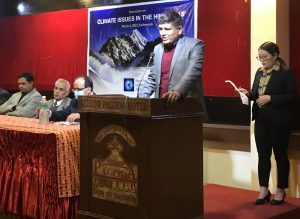
In preparation for the Himalayan Climate Bootcamp, to be held in conjunction with Earth Day from 22-24 April, organizers gathered at the Yellow Pagoda Hotel in Kathmandu to consider the elements of their program. There were 55 participants, including the project team leader, deputy team leader, executive members of Nepal Forum of Science Journalists (NFSJ), environment and climate science journalists, development professionals, academics, and environmental science students. Together they reviewed the various dimensions of climate change in the Himalayan region that will be discussed at next month’s Boot Camp, which range from the issues of glacier melting to impact on fresh water ecosystems and livelihood.
According to Chhatra Karki, Founding President of Nepal Forum of Science Journalists, the Boot Camp aims to bridge the gap between climate researchers and science journalists. With thematic presentations followed by interaction, attendees will dig deeper into the pertinent climate issues emerging in the Himalayan region through.
The event’s chief guest was Dr. Dinesh Raj Bhuju, Academician with the Nepal Academy of Science and Technology (NAST). He described climate change as a pressing issue of the 21st century that calls for continuous research and investigation.
“Calculating the rise in temperature as an impact of climate change using the principles of physical chemistry, Nobel Laureate Svante Arrhenius predicted the phenomenon some 125 years ago”, he said .
Bhuju added that it still took a long time to gain the attention of influential policymakers, such as former US vice-president Al Gore and others. In the absence of evidence-based research, the impact of climate change in the Himalayan region was an utterly neglected issue for several years that is only now drawing such attention.
These observations were focused in a reflective speech by Aang Tsiring Sherpa, a Nepali mountaineer and tourism entrepreneur from the Sherpa community and a first-hand witness to changes in the Himalayas over the last six decades. He lamented the ignorance of media towards the growing challenges of climate change and other disasters in the region, which is an unstable and seismically active ecological landscape.
“There were more than 3,000 glaciers in the 1960s,” remarked Mr. Sherpa, describing these as water towers for billions of people. “But many of these glaciers have become endangered, including the Imja Tsho, at a height of 5010 metres.”
Another representative of NAST, Member Secretary Mahesh Kumar Adhikari, expressed his pleasure that Nepal Forum of Science Journalists organized this interactive program. He noted that Nepal belongs to the central Himalayan zone, where investigations on the impact of climate change are of paramount importance. Species such as algae, mushroom, and lichens, are moving higher and higher, he added, while habitats of birds and other animals are also being affected. More specifically, freshwater ecosystems are likewise altered by climate change, said Dr. Ram Devi Tachamo Shah, Assistant Professor at Kathmandu University’s Department of Environment Science. She outlined how the habitat of the aquatic species, including insects, have been all too apparent.
During the thematic session, Dr. Santosh Nepal, a climate researcher at the International Water Management Institute, cited the sixth assessment report of the UN’s Intergovernmental Panel on Climate Change to indicate the gravity of observations such as hotter weather and droughts in 2005 and 2006. His view was echoed by
Dr. Rijan Bhakta Kayastha, a glaciologist and associate professor at Kathmandu University. His work over the past few years has shed light on the problems of glacial retreat, especially the halt in ice formation below 6000 metres in altitude. Kayastha urged science journalists at the event to cover such issues with more emphasis.
Another presentation, by Dr. Maheshwor Dhakal, Joint secretary at Nepal’s Ministry of Environment and Forest, examined the relationship between climate change and humanity. Rather than simply complaining about climate change, he insisted, it is imperative to look at adaptation strategies.
Finally, in closing remarks by former Minister of Science and Technology Ganesh Shah, he expressed his sincere thanks to NFSJ for organizing this event. He also called on science journalists to work towards decoding the language of the researchers, so that the broadest possible audience could understand the findings of scientific studies in simple terms.